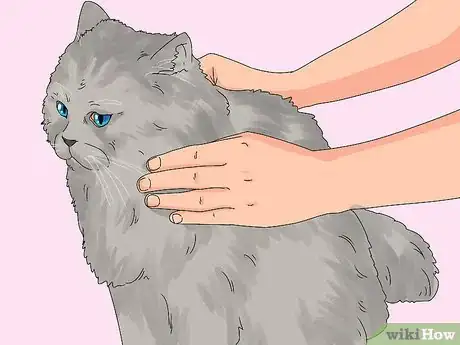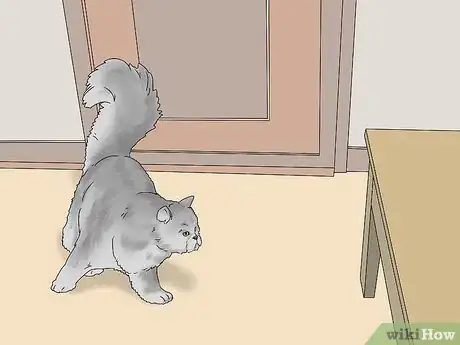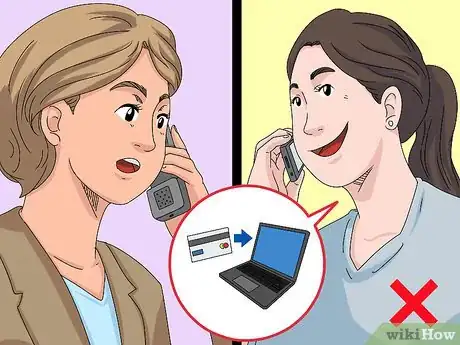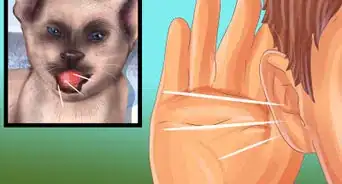This article was co-authored by Pippa Elliott, MRCVS. Dr. Elliott, BVMS, MRCVS is a veterinarian with over 30 years of experience in veterinary surgery and companion animal practice. She graduated from the University of Glasgow in 1987 with a degree in veterinary medicine and surgery. She has worked at the same animal clinic in her hometown for over 20 years.
There are 8 references cited in this article, which can be found at the bottom of the page.
This article has been viewed 157,481 times.
Identifying any cat by breed can be tricky due to the many variations that breed can have. If you're looking for a pure-bred Persian cat, it may be even more difficult to find a breeder who can verify the cat's genetics. However, Persian cats are quite distinct, both in appearance and demeanor. Knowing what a Persian cat looks like and how it behaves can help simplify your search for your new feline companion.
Steps
Identifying a Persian Cat By Physical Characteristics
-
1Recognize a Persian cat's face. Persian cats tend to have very round faces with full, puffy cheeks. The nose is "snubbed," and therefore not very prominent. Their eyes are usually large and expressive and may be colored blue, amber, or a mix of the two. Meanwhile, the ears tend to be very small and round-tipped in appearance.[1]
- While many Persian cats tend to have flat faces, there are variations. Some Persians have a more rounded facial shape, which breeders often refer to as a doll-faced Persian.[2]
-
2Look at the coat length and texture. The coat of a Persian cat tends to be very distinct. Persians typically have long fur with a silky texture. Their fur needs to be combed every day to avoid getting knots and tangles, and mats may need to be trimmed out from time to time.[3]
- Most Persians will require daily grooming that lasts at least 10 to 15 minutes, plus an hour-long grooming session once every week.[4]
Advertisement -
3Check the color of the coat. Though many people picture a white cat when they think of Persians, these cats can come in a wide variety of colors. Some of the most common colors include white, red, cream, black, brown, blue-gray, chocolate, lilac, silver, golden, tortoiseshell, blue-cream, calico, and seal (usually a mix of cream and brown/black).[5]
-
4Examine the coat pattern. There are numerous variations of the coat pattern seen in Persian cats. Breeders who raise Persians for cat competitions have divided the most common Persian patterns into seven categories (called divisions) to more easily identify what type of Persian you're adopting or purchasing.[6]
- Solid Division - this category implies that the cat has a single, uniform coat color. Most solids have copper-colored eyes, but white Persians may have copper, blue, or one of each.
- Silver & Golden Division - Persians in this category have either chinchilla (sparkling white with fine black tips) coats or shaded silver and golden coats. Goldens have a warm, creamy coat with black tips, and silvers usually have black down the back with even shading down the sides.
- Shaded & Smoke Division - shaded Persians tend to have a shell and shaded-cameo coats, typically with a white undercoat and tips that are red, cream, black, or blue-cream. Smoke Persians appear to have a solid colored coat, but close examination reveals a white undercoat.
- Tabby Division - tabby Persians have either classic, mackerel, or patched tabby patterns. Classic tabbies have a bull's eye pattern along the side, and mackerel tabbies have thin lines that appear drawn around the entire body.
- Parti-color Division - this category includes Persians that have tortoiseshell, chocolate tortoiseshell, blue-cream, and lilac-cream coats. These coats tend to be a solid color (usually black or cream) with patches of red.
- Calico & Bicolor Division - this category includes calico patterns and dual-colored coats. All cats in this division have copper eyes, except for silver tabbies, which may have green or hazel eyes.
- Himalayan Division - these Persians tend to have white or cream bodies with point colors restricted to the face and extremities. Cats in this division will always have blue eyes.
-
5Look at the tail. Persian cats typically have a distinct tail. It's usually short and lofted upward. The tail is usually straight with little to no curvature, and Persians usually carry the tail at an angle below the back.[7]
-
6Check the cat's body shape. Persian cats have a distinctly short, stocky body shape. They tend to be slightly heavier than the average cat, though their bodies remain somewhat compact.[8]
- A Persian cat's legs have heavy bones that carry the medium- to large-sized body.
- The shoulders are usually broad, with an overall thick, compact body. The neck is also short and thick.[9]
- Female Persians generally weigh between 8 to 12 pounds. Male Persians typically weigh over 12 pounds.
-
7Order an at-home DNA test. Look for a test kit from a reputable online site, like one affiliated with a university. You'll swab your cat's cheek a couple of times and send the samples to a lab, where scientists will conduct DNA tests to tell you what breed your cat is.[10] The test is 90% accurate and can be a great way to confirm whether your cat is a true Persian or not.[11]
Recognizing Persian Cat Behavior
-
1Look for a playful but reserved personality. Though every cat is unique, Persians in general tend to have a distinct personality type. They are playful in their own way, yet reserved and somewhat docile for the most part. Unlike other cat breeds, Persians are not particularly known for jumping or climbing.[12]
- Persian cats tend to prefer sitting in a person's lap or lying in the sun over more physical activities.
- They tend to not be very demanding of people's affection. Sitting or reclining in a person's lap is usually sufficient for most Persians.
- Persians often get frightened or annoyed with loud noise and/or poorly-behaved children.
-
2
-
3Keep a Persian's surroundings familiar. Persians are generally not very welcoming to surprises.[15] Because of this, taking a Persian cat to an unfamiliar environment may be jarring and unpleasant to your cat. If you are planning on leaving town for a few days, a Persian may need someone to visit your home and care for him or her, rather than being boarded in unfamiliar territory.[16]
- If you plan on making changes to your home, like buying new furniture, it may be best for your cat to introduce that furniture gradually instead of all at once.
- If you move to a new home, make sure some of your old furniture is there before you bring your cat. This can make the transition easier for a Persian.
-
4Identify common health complications in Persians. Like many purebred cats, Persians are prone to certain health complications at some point in life. Some may not significantly affect the cat's quality of life, while others can be quite serious.[17] Some of the most common health complications seen in Persian cats include:
- Basal cell tumors
- Cataracts
- Deafness (especially common in blue-eyed Persians)
- Cryptorchidism
- Entropion
- Facial fold dermatitis
- Lysosomal storage disease
- Peritoneopericardial hernia
- Polycystic kidney disease
- Progressive retinal atrophy
- Systemic lupus
- Hypertrophic cardiomyopathy
- Portosystemic shunt
- Gingivitis
- Corneal sequestration
- Hip dysplasia
- Strabismus/nystagmus
- Dermatophytosis
Finding a Reputable Persian Breeder or Seller
-
1Find a reputable breeder. If you want a Persian kitten, you may have to go through a breeder. However, it's important that you only work with reputable breeders. This helps ensure your cat's health and its true breed identity, and it also helps reduce business for disreputable or illegal breeders.[18]
- A reputable breeder will offer you health certifications that prove that the cat has been screened for genetic health complications.
- Reputable breeders typically make kittens available when they are between 12 and 16 weeks old. Kittens sold before 12 weeks of age may not be inoculated and will lack the physical and social strength to adjust to a new home.[19]
- Ask if you can tour the facility, which any reputable breeder should be able to accommodate. Look for any signs of sick animals or unsanitary/unhealthy living conditions.
- You can ask your veterinarian for a list of reputable breeders in your area. If a vet recommends a breeder, there's a good chance that the breeder follows acceptable practices.
-
2Look out for warning signs of a bad breeder. If you choose to work with a breeder, make sure you know what to look for. In addition to having health certifications and an open facility, a reputable breeder should have limitations on the number and variety of kittens available at any given time. A reputable breeder will also be more particular about how you can pay for your cat once you've worked out an arrangement and chosen a kitten.[20]
- Any breeder who has kittens continuously available or houses multiple litters should be seen as a red flag. Also, anyone selling kittens younger than 12 weeks of age is probably a disreputable breeder.[21]
- Ask the breeder whether he or she sells to pet stores and wholesalers. Reputable breeders are bound by a code of professional ethics that bans this practice, and any breeder who makes these sales is not to be trusted.
- If the breeder allows you to pay online using a credit card, it might be a scam or a disreputable breeder. Most breeders will want you to pay in person, usually with cash or a check.
-
3Try adopting a Persian from a rescue or shelter. Persian kittens are incredibly rare to find in an animal rescue or shelter, but adult Persian cats are frequently available for adoption. If you check at a few different rescues or shelters, you will find both mixed-breed and pedigreed Persian cats looking for a home.[22]
- You can try visiting shelters and rescues in your area, or you can search online with listings like Petfinder or Adopt-a-Pet. Some online listings may allow you to search by breed, which can help you narrow down your search for a Persian.
- You can also search online for Persian breed-specific rescue groups in your area. These groups specialize in finding homes for a given breed and can be an excellent resource for finding and adopting your own Persian cat.
References
- ↑ http://www.vcahospitals.com/main/cat-care/cat-breeds/persian
- ↑ http://www.breedlist.com/persian-breeders.html
- ↑ http://www.hillspet.com/en/us/cat-breeds/persian
- ↑ http://www.breedlist.com/persian-breeders.html
- ↑ http://www.hillspet.com/en/us/cat-breeds/persian
- ↑ http://cfa.org/Breeds/BreedsKthruR/Persian.aspx
- ↑ http://www.vcahospitals.com/main/cat-care/cat-breeds/persian
- ↑ http://www.vcahospitals.com/main/cat-care/cat-breeds/persian
- ↑ http://www.hillspet.com/en/us/cat-breeds/persian
- ↑ http://www.vgl.ucdavis.edu/services/cat/ancestry/faq.php#10
- ↑ https://www.wired.com/2012/07/cat-ancestry-test/
- ↑ http://www.vcahospitals.com/main/cat-care/cat-breeds/persian
- ↑ http://www.vetstreet.com/cats/persian#1_8jk7ll4g
- ↑ http://www.acfacat.com/persian_synopsis.htm
- ↑ http://www.vcahospitals.com/main/cat-care/cat-breeds/persian
- ↑ http://www.vetstreet.com/cats/persian#1_8jk7ll4g
- ↑ http://www.vcahospitals.com/main/cat-care/cat-breeds/persian
- ↑ http://www.vetstreet.com/cats/persian#1_8jk7ll4g
- ↑ http://cfa.org/Breeds/BreedsKthruR/Persian.aspx
- ↑ http://www.vetstreet.com/cats/persian#1_8jk7ll4g
- ↑ http://cfa.org/Breeds/BreedsKthruR/Persian.aspx
- ↑ http://www.vetstreet.com/cats/persian#1_8jk7ll4g
About This Article
To identify a Persian cat, check to see if the cat has a round face with puffy cheeks and a snubbed nose, which are typical Persian cat features. You should also look for its fur to be long and have a silky texture. Additionally, look at the color of the cat's fur, since Persian cats are usually white, red, cream, or black. If you're still unsure if the cat is a Persian cat, check out its tail to see if it's short and slightly curved, which is a sign it's a Persian cat. For tips on how to find a reputable Persian cat breeder, keep reading!










































































